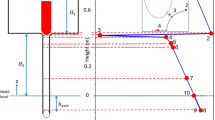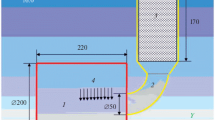Abstract
For a long time it has been recognized that flow of metal in the liquid pool at the head of a continuous caster can have a significant effect on the operability of the caster and the quality of the steel produced. Poorly engineered flows can result in thinning of the shell produced in the mold, with consequent danger of breakouts, entrapment of inclusions or gas bubbles, as well as macrosegregation. There can be similar impacts of the flow in the DC casting of aluminum, Flows are controlled, in the case of steel casting, by the design of the submerged entry nozzle (SEN) and by auxiliary devices sych as electromagnetic brakes and stirrers. In the case of aluminum casting, it is common practice to place a ceramic “bag” around the SEM to control the flow. Usually the design of these devices involves much empiricism; the metal pools arc hot and difficult to access, and flow measurements are therefore difficult. Some use has been made of mathematical and physical models in developing flow control devices. The difficulty with the former is that the flows are turbulent and in a volume with an irregular geometry; consequently, model predictions are questionable unless tested in some way. Such testing can be done using physical models which can also provide their own insights into the nature of the flow. Unfortunately, most physical modeling of casters in the past has been qualitative, or semi-quantitative. The paper describes a project at Berkeley where quantitative results are being obtained from a physical model of a caster with the help of particle image velocimctry (PIV), In this technique (cross correlation PIV), a digital camera records an image of tracer particles scattered throughout the flow. A second image is recorded 33milliseconds later and the two digital images are interrogated by commercial software (Optical Flow Systems. Edinburgh. Scotland) to determine the motion of the particles from one image to the next and yield a vector map of the flow. The technique has been extended to yield time averaged velocity vectors for turbulent flows (the case in the casters and models) by ensemble averaging the vectors from many pairs of images. Water models, including full sized ones, have been constructed for steel and aluminum casters. Various SENs and bags can be used in the model and their effects measured by PIV. Results show that the orientation of the two ports at the bottom of the SEN has a strong effect on the flow in steel casting. The water model of the aluminum caster has shown the strong effect of the bag geometry, and of bag misalignment, on flow in the liquid pool. The commercial software FIDAP has been used to compute time averaged velocities in the physical models. Agreement between measurements and predictions varies from good to fair, depending on conditions.
Similar content being viewed by others
References
S. Yokoya, Y. Asako, S. Hara and J. Szekcly,IS1J Int. 34, 883 (1994).
J. Hcrbertson, Q. L. He, P. J. Flint, R. B. Mahapatra,Steelmaking Conf. Proc. 74, 171 (1991).
D. J. Harris and J. D. Young,Steelmaking Conf. Proc. 65, 3 (1982).
D. Gupta and A. K. Lahiri,Metall. Trans. 27B, 757 (1996).
X. K. Lan, J. M. Khodadadi and F. Shen,Metall. Trans. 28B. 321 (1997).
D. Gupta and A. K. Lahiri,Metall Trans. 25B. 227 (1994).
D. Gupta, S. Chakraborty and A. K. Lahiri.ISIJ Int.,37, 654 (1997).
J. Szekciy and R. T. Yadoya,Metall Trans. 3, 2673 (1972).
B. G. Thomas, X. Huung and R. C. Siissman.Metall Trans. 25B, 527 (1994).
D. Xu, W. K. Jones, Jr. J. W. Eivans and D. P. Cook, inLight Metals 1998 (ed.. B. Welch), p. 1045, TMS, Warrcndalc. PA (1998).
W. K. Jones, Jr., D. Xu and J. W. Evans, inLight Metals 1998 (ed., B. Welch), p. 1051, TMS, Waircndale, PA(1998).
Author information
Authors and Affiliations
Rights and permissions
About this article
Cite this article
Evans, J.W., Xu, D. & Jones, W.K. Physical and mathematical modeling of metal flow in the continuous casting of Steel and Aluminum. Metals and Materials 4, 1111–1118 (1998). https://doi.org/10.1007/BF03025984
Issue Date:
DOI: https://doi.org/10.1007/BF03025984




